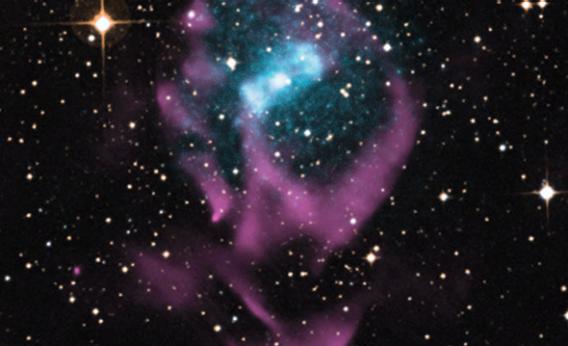Create a free profile to get unlimited access to exclusive videos, sweepstakes, and more!
Congratulations! It’s a Bouncing Baby Neutron Star!

Millennia ago, and 26,000 light years distant in the dim and somewhat unremarkable constellation of Circinus, a monster was born. And when that happened, it gave out a heck of a birth cry.
The baby in this case was a neutron star, and the bawling was the eruption of a supernova, the titanic and ridiculously powerful explosion that results from the death of a massive star.
That star probably started out with about 8 â 20 times the mass of our Sun. It was in a tight orbit around another massive star, the two circling each other every two weeks or so. At its heart, the star was fusing lighter elements into heavier ones; it was a gigantic nuclear furnace.
Eventually, after a few million years, that fuel ran out. The core collapsed, releasing a mind-numbing blast of energy. This blew out the upper layers of the star, ejecting them at a substantial fraction of the speed of light, creating the supernova. The core itself collapsed, forming an über-dense ball of subatomic neutrons few kilometers across. The explosion was probably not symmetric, but was instead slightly off-balance, providing an immense kick to the newly-formed neutron star.
The resulting system staggers the imagination: a white-hot star with the mass of the Sun but the size of a small city on a highly elliptical orbit around a normal (but also massive) star, sitting in the center of a vast cloud of superheated material screaming away at thousands of kilometers per second. Both the hot gas and the baby neutron star are so energetic they blast out X-rays⦠which is how we figured all this out.
Circinus X-1, as the system is called, is a high-mass X-ray binary, a pair of heavy stars in orbit around each other. We know of quite a few objects like this in the galaxy, but most of them are pretty old. But new observations of Cir X-1 have given astronomers a vital piece of information about it: its age. As the gas from the explosion slams into material around it, it slows down and cools, emitting X-rays. The physics of this is pretty well understood, and by measuring the temperature of the gas from the X-rays, astronomers determined the explosion must have occurred no more than 4600 years ago (and it may be younger still). This makes it by far the youngest high-mass X-ray binary ever found.
Thatâs a huge piece of the puzzle. As these binary systems age, they change. They cool off, they emit X-rays in different ways, the orbits of the stars change. Because this system is so young itâs a safe bet that what we see now is pretty much how it was when it formed. That allows astronomers to understand what was going on when the star exploded in the first place. Thatâs critical; imagine trying to understand how a baby human behaves by only studying adults. Thereâs a lot you could figure out, but you really want to be able to study a baby itself to know whatâs what.
Now we have that baby. An octillion ton superhot baby.
I love the physics and science of this, how the pieces came together to figure it all out â Iâve spent my share of time studying supernovae. But despite all the technical details, one thing still strikes meâ¦
Something over four millennia ago, humans didnât have telescopes. When the light from the supernova reached Earth, Mesopotamia, Sumeria, and Egypt were flourishing, but the star was too far south for them to see well, or at all. Circinus is best seen from south of the Equator, where most cultures were hunter/gatherers; in South America for example the shift to farming was just getting started.
We know even very ancient civilizations were keen observers of the night sky; the cycles of the Sun throughout the year are tied to the seasons, and to a burgeoning agricultural civilization the import of that is obvious. The constellation of Circinus itself is nothing to notice; the stars in it are faint.
Until one day, one wasnât. We have little or no records of astronomical observations from that part of world from back then. So I wonder, what did these people make of the sudden appearance of a new star in the sky, so bright it could have been the twin of Venus? Did they stand and gape at it, awe-struck, as it brightened over a few days and faded over months? What legends were spawned, what ideas were wrought, what fear or wonder was instigated?
If such an event were to happen now it would be the most significant astronomical event in the past several decades; every telescope on the planet and above it would be trained on the exploding star. We would study it, analyze it, dissect the information pouring in from it across all those thousands of light years. The knowledge we would gain would be unparalleled.
Yet I can also wish that given that chance, I would want to see it myself, to stand under the night sky and let the light that had traveled so far enter my eyes, tickle my brain. I can easily imagine the shiver that would travel down my neck as I soaked in the wonder of what I was seeing, the knowledge of what it truly is.
Perhaps we know more now than our ancestors did, with our basis of understanding through science, and our remarkable tools to investigate nature. But we still have much in common with them, and to stand in awe of the beauty of our surprising Universe is a characteristic I hope we never lose.


























